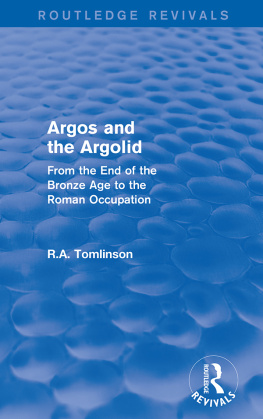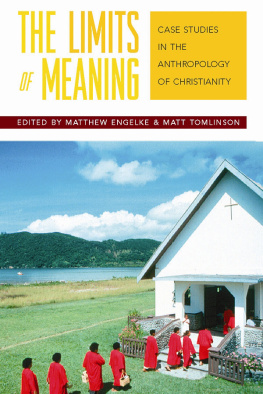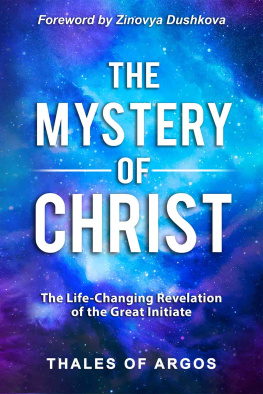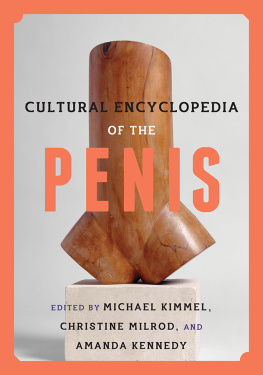Tomlinson - Argos and the Argolid
Here you can read online Tomlinson - Argos and the Argolid full text of the book (entire story) in english for free. Download pdf and epub, get meaning, cover and reviews about this ebook. publisher: Taylor & Francis (CAM), genre: Religion. Description of the work, (preface) as well as reviews are available. Best literature library LitArk.com created for fans of good reading and offers a wide selection of genres:
Romance novel
Science fiction
Adventure
Detective
Science
History
Home and family
Prose
Art
Politics
Computer
Non-fiction
Religion
Business
Children
Humor
Choose a favorite category and find really read worthwhile books. Enjoy immersion in the world of imagination, feel the emotions of the characters or learn something new for yourself, make an fascinating discovery.
Argos and the Argolid: summary, description and annotation
We offer to read an annotation, description, summary or preface (depends on what the author of the book "Argos and the Argolid" wrote himself). If you haven't found the necessary information about the book — write in the comments, we will try to find it.
Argos and the Argolid — read online for free the complete book (whole text) full work
Below is the text of the book, divided by pages. System saving the place of the last page read, allows you to conveniently read the book "Argos and the Argolid" online for free, without having to search again every time where you left off. Put a bookmark, and you can go to the page where you finished reading at any time.
Font size:
Interval:
Bookmark:
Routledge Revivals

Argos and the Argolid
Argos and the Argolid, first published in 1972, presents a study of the history and achievements of the Argives, who have hitherto been largely neglected: partly because Classical Argos is overshadowed by the legends of an earlier millennium, and partly because many of her monuments and records have been lost.
Richard Tomlinson describes the region, and considers the relationship between the Argives who claimed Dorian descent and those whose ancestors were in all probability the inhabitants of the region during the Bronze Age. In particular, he emphasises the Argives role as a third force in mainland Greek history, where they challenged the supremacy of the Spartans in Peloponnesian affairs.
This thorough treatment is intended to correct the usual bias in favour of the better documented affairs of Athens and Sparta. It includes an assessment of Argive military and political organisation, and of their contribution to the arts of Ancient Greece.
Argos and the Argolid
From the End of the Bronze Age to the Roman Occupation
R.A. Tomlinson

First published in 1972
by Routledge & Kegan Paul Ltd
This edition first published in 2014 by Routledge
2 Park Square, Milton Park, Abingdon, Oxon, OX14 4RN
and by Routledge
711 Third Avenue, New York, NY 10017
Routledge is an imprint of the Taylor & Francis Group, an informa business
1972 R.A. Tomlinson
The right of R.A. Tomlinson to be identified as author of this work has been asserted by him in accordance with sections 77 and 78 of the Copyright, Designs and Patents Act 1988.
All rights reserved. No part of this book may be reprinted or reproduced or utilised in any form or by any electronic, mechanical, or other means, now known or hereafter invented, including photocopying and recording, or in any information storage or retrieval system, without permission in writing from the publishers.
Publishers Note
The publisher has gone to great lengths to ensure the quality of this reprint but points out that some imperfections in the original copies may be apparent.
Disclaimer
The publisher has made every effort to trace copyright holders and welcomes correspondence from those they have been unable to contact.
A Library of Congress record exists under LC control number: 72193299
ISBN 13: 978-1-138-01989-8 (hbk)
ISBN 13: 978-1-315-77860-0 (ebk)
Argos and the Argolid
From the end of the Bronze Age to the Roman occupation
R. A. Tomlinson
Professor of Ancient History and Archaeology, University of Birmingham

First published 1972
by Routledge & Kegan Paul Ltd
Broadway House, 6874 Carter Lane, London EC4V 5EL
Printed in Great Britain by Western Printing Services Ltd, Bristol
R. A. Tomlinson 1972
No part of this book may be reproduced in any form without permission from the publisher, except for the quotation of brief passages in criticism
This edition is not for sale in the United States of America, its dependencies, and the Philippine Republic.
ISBN 0 7100 7254 6
FOR HEATHER
Plates
Figures
This book is an indirect result of three seasons spent excavating at Perachora, which comes under the Argolid division of the Greek Archaeological Service, and of visits paid then to members of the service; I should like here particularly to record my tribute to the late S. Charitonides, then Ephor of Antiquities. The book is also a reaction against the all-consuming attention which the Bronze Age in the Argolid has received and it therefore makes no attempt to present yet another account of that age, though the fact of its existence is of necessity the starting-off point for my argument. The difficulties involved in the attempt to present a coherent account of a region whose history and achievements were inadequately recorded in antiquity are considerable; inevitably gaps and inconsistencies result. The Argolid was not so prominent in the first millennium B.C. as it would seem to have been in the second, and I have not tried to exaggerate its importance. Nevertheless, when the history of mainland Greece in the Classical Age is so readily concerned with the affairs of Sparta and Athens, the cities which undoubtedly dominated it, the investigation of a state of lesser rank is not without its value. Not all the cities of mainland Greece were supporters of one or other of the two leaders, and in the history of Argos it is easier to appreciate their point of view.
I am deeply indebted to Professor R. F. Willetts, who urged me to write this book and has given me every encouragement. I am grateful to the University of Birmingham for giving me a research grant which enabled me to write the section on the topography of the Argolid from first-hand knowledge and to take the photographs. I should like also to thank my assistants in the Department of Ancient History and Archaeology at Birmingham, Mrs Brenda Timmins who made the map and the other drawings and Mrs Gillian Davies who patiently translated my almost illegible scrawl into a typescript.
It is usual to explain in the preface the principles on which Greek words have been transliterated into English. It will soon be apparent that I am inconsistent in my approach to this problem, for I find forms such as Krete and Korinth pedantic, and others, such as Polyclitus, ugly. To those readers whom my lack of method offends, I tender my sincere apologies.
Argos has been unfortunate in her history. In the Heroic time of the Late Bronze Age, before history was written and great events and great names were recorded only in traditions handed down by word of mouth, the region round Argosthe Argolidwas about the most important in all Greece. It contained the city ruled by Agamemnon, whom Homer regarded as overlord of all the Greeks, even though modern scholars may disagree with him; the name of that city, Mycenae, is often used to describe the entire Late Bronze Age of Greece. In the Argolid the remains of that Mycenaean age, at Mycenae, at Tiryns and elsewhere are the most spectacular antiquities that survive, their walls piled high with such massive boulders
By contrast, in historic times Classical Argos is a neglected area. It was no longer a region of first importance, and the lead in Greek affairs passed to other statesto Corinth, to Sparta and to Athens. Increasingly Argos was involved in a struggle to maintain her independence, and in a history that inevitably reflects the Spartan or Athenian point of view, her struggles often involve her in action that appears to condemn her as a traitor to Hellenism, in her readiness to make friends with the enemies of that other Greek world of Sparta and Athens, firstly with the King of Persia, and then, more successfully, with the kings of Macedon. Little of Argive history is recorded, and inevitably that occurs chiefly when she is involved with other Greek states. Argos produced no great historian, no Herodotus or Thucydides, whose writings were preserved during the merciless rejection of the less relevant or readable in Late Roman or Byzantine times. Argos produced no great statesmen in the Classical Age, and no citizen that emerges in recorded history as a recognizable individual, in the way that the great Athenians still live for us. Her chief political figures are a king whose achievements belong to the remote days that saw the original formation of the classical city state (and whose date is a matter of some dispute), and a series of autocratic despots who governed her in the third century B.C. and who are known ultimately from the writings of men who were their bitter enemies. Argos has for us no literature, no poetry, no drama. At the present day the Argolid contains no striking archaeological remains other than those of the Bronze Age to attract the attention of the traveller. The chief classical sanctuary, the Heraion, now comprises only blank terrace walls and bare foundations. The most spectacular ruins in Argos itself belong to the Roman period.
Next pageFont size:
Interval:
Bookmark:
Similar books «Argos and the Argolid»
Look at similar books to Argos and the Argolid. We have selected literature similar in name and meaning in the hope of providing readers with more options to find new, interesting, not yet read works.
Discussion, reviews of the book Argos and the Argolid and just readers' own opinions. Leave your comments, write what you think about the work, its meaning or the main characters. Specify what exactly you liked and what you didn't like, and why you think so.














